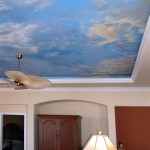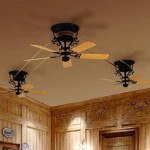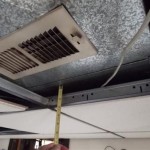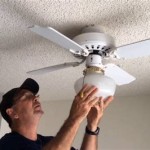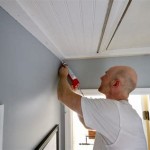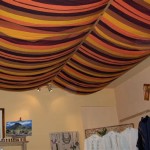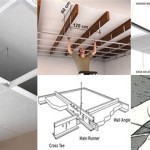Mounting A Fan On Sloped Ceiling Joists: A Comprehensive Guide
Installing a ceiling fan on a sloped ceiling joist presents a unique challenge compared to a standard flat ceiling installation. The angle requires careful planning and specialized hardware to ensure the fan hangs correctly, operates safely, and distributes air effectively. This article provides a comprehensive guide to mounting a ceiling fan on sloped ceiling joists, covering essential considerations, necessary tools and materials, step-by-step instructions, and crucial safety precautions.
Key Point 1: Understanding the Challenges and Necessary Preparations
The primary challenge in mounting a fan on a sloped ceiling joist is achieving a secure and level installation. Without proper preparation, the fan may hang crookedly, vibrate excessively, or even detach from the ceiling, posing a significant safety hazard. Therefore, a thorough understanding of the slope angle and the joist structure is crucial. Before commencing the installation, several key preparations are necessary.
First, determine the slope of the ceiling. This is typically expressed as a ratio of the rise to the run (e.g., 4/12). The slope dictates the type of mounting hardware required. For steeper slopes, specialized angled mounting brackets or extension rods are often necessary. A level and an angle finder tool are indispensable for accurately measuring the ceiling's slope.
Next, inspect the ceiling joists. Ensure that the joist selected for mounting is structurally sound and capable of supporting the weight of the ceiling fan. A standard ceiling fan typically weighs between 20 and 50 pounds. If the joist appears weak or damaged, reinforce it before proceeding. This might involve adding additional bracing or sistering a new joist alongside the existing one.
Finally, assess the electrical wiring. Confirm that the wiring is adequate for the ceiling fan's electrical requirements and that it is properly grounded. If the wiring is outdated or insufficient, consult a qualified electrician to upgrade it to meet current electrical codes. Failure to do so can create a fire hazard.
Before starting work, turn off the power to the circuit at the breaker box. Verify the power is off using a non-contact voltage tester or a multimeter. This step is crucial to prevent electrical shock during the installation process.
Key Point 2: Selecting the Appropriate Hardware and Tools
Choosing the right hardware is paramount for a successful and safe installation. Standard ceiling fan mounting kits are not designed for sloped ceilings. Specialized kits or individual components are necessary to accommodate the angle and ensure proper support.
Angled mounting brackets are designed to compensate for the ceiling's slope. These brackets typically feature adjustable angles that allow the fan to hang level. Select a bracket that is compatible with the ceiling fan's mounting plate and capable of supporting its weight. Some brackets also incorporate vibration dampening features, which can reduce noise during fan operation.
Extension rods, also known as downrods, are used to lower the fan from the ceiling. On sloped ceilings, an extension rod is often necessary to provide adequate clearance between the fan blades and the ceiling. The length of the extension rod will depend on the ceiling's slope and the desired height of the fan. Ensure that the extension rod is compatible with the ceiling fan and the mounting bracket.
In addition to specialized hardware, several essential tools are required for the installation. These include a stud finder to locate the ceiling joist, a drill with various drill bits, a screwdriver set (both Phillips head and flathead), a wire stripper, wire connectors, electrical tape, a level, a measuring tape, and safety glasses.
When selecting wire connectors, choose options that are suitable for the gauge of the wiring and rated for the voltage and current requirements of the ceiling fan. Using incorrect wire connectors can lead to loose connections and electrical hazards.
Furthermore, consider using a ceiling fan brace. These braces provide extra support and are installed between the joist and the fan mount. They can be especially helpful on older homes where the existing joists may not be perfectly aligned or sufficiently strong.
Key Point 3: Executing the Installation Process Safely and Accurately
With the necessary preparations completed and the appropriate hardware and tools assembled, the installation process can commence. The following steps outline the procedure for mounting a ceiling fan on sloped ceiling joists.
First, locate the ceiling joist using a stud finder. Mark the location of the joist on the ceiling. The center of the joist is the ideal mounting point. If reinforcing the joist, do so before proceeding to the next step.
Next, install the angled mounting bracket. Align the bracket with the marked location on the joist and secure it using lag screws or other appropriate fasteners. Ensure that the bracket is firmly attached and can support the weight of the fan. Use a level to ensure the bracket is aligned correctly.
Assemble the ceiling fan according to the manufacturer's instructions. This typically involves attaching the fan blades to the motor housing and connecting the wiring. Refer to the fan's wiring diagram for correct connections.
Connect the fan's wiring to the electrical wiring in the ceiling junction box. Use wire connectors to join the wires, ensuring a secure and insulated connection. Typically, the black wire from the fan connects to the black wire in the junction box (hot), the white wire from the fan connects to the white wire in the junction box (neutral), and the green or bare wire from the fan connects to the green or bare wire in the junction box (ground). Wrap electrical tape around the wire connectors for extra insulation.
Attach the ceiling fan to the mounting bracket. This typically involves aligning the fan's mounting plate with the bracket and securing it with screws. Ensure that the fan is securely attached and hangs level.
Install the extension rod, if necessary. Follow the manufacturer's instructions for attaching the extension rod to the fan and the mounting bracket. Make sure the extension rod screws are securely fastened.
Once the fan is mounted, test its operation. Turn on the power at the breaker box and verify that the fan spins smoothly and quietly. Check the fan's speed settings and ensure that the light fixture (if applicable) functions correctly. If any problems are encountered, immediately turn off the power and troubleshoot the issue. Common problems include loose wiring connections, unbalanced fan blades, or faulty switches.
After verifying the fan's operation, conceal the wiring and mounting hardware with the fan's canopy. The canopy is a decorative cover that hides the electrical connections and provides a finished look. Secure the canopy to the mounting bracket with screws.
Finally, double-check all connections and fasteners to ensure that the fan is securely mounted and operating safely. Periodically inspect the fan for any signs of wear or loosening. Tighten any loose screws or fasteners as needed. Cleaning the fan blades regularly can also help to prevent dust buildup and maintain optimal performance.
Properly mounting a ceiling fan on sloped ceiling joists requires meticulous attention to detail, a thorough understanding of the installation process, and adherence to safety precautions. By following these guidelines, individuals can ensure a safe and effective fan installation that enhances comfort and energy efficiency.

Electrical Mount Ceiling Fan At The Peak Of A Sloped Home Improvement Stack Exchange

Mounting Ceiling Fan On Sloped Home Improvement Stack Exchange

Mounting Ceiling Fan On Sloped Home Improvement Stack Exchange

Diy Cathedral Mount Ceiling Fan Box The Shabinlife

Hunter Fans How To Install Your Ceiling Fan Cpo S
How To Install A Ceiling Fan On Vaulted Quora

Electrical Mount Ceiling Fan At The Peak Of A Sloped Home Improvement Stack Exchange

Electrical Mount Ceiling Fan To Joist On Sloped Home Improvement Stack Exchange

Installing Ceiling Fans

Want To Install An Outdoor Ceiling Fan Directly Exposed 2x4 On A Covered Porch Home Improvement Stack Exchange
Related Posts

